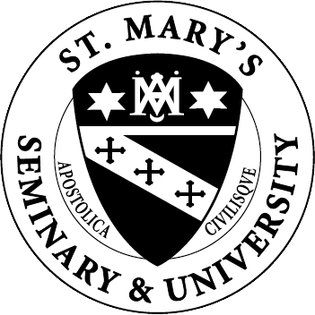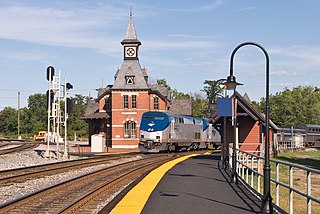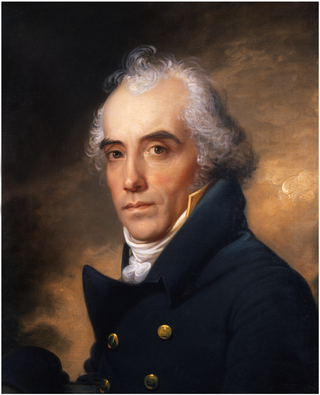
St. Mary's Seminary and University is a Catholic seminary located within the Archdiocese of Baltimore in Baltimore, Maryland; it was the first seminary founded in the United States after the Revolution and has been run since its founding by the Society of the Priests of Saint Sulpice.
Robert Cary Long Jr. (1810–1849) was the son of a late 18th Century - early 19th Century famous architect Robert Cary Long Sr. of Baltimore, Maryland and was himself a well-known 19th Century architect. Like his father, Cary was based in Baltimore.

St. Charles College was a minor seminary in Catonsville, Maryland, originally located in Ellicott City, Maryland.

Ephraim Francis Baldwin was an American architect, best known for his work for the Baltimore and Ohio Railroad and for the Roman Catholic Church.

John Dubois served as the third bishop of the Roman Catholic Diocese of New York from 1826 until his death in 1842. He was the first Bishop of New York who was not Irish-born and, as of 2024, remains the only bishop or archbishop of New York who was not either of Irish birth or of Irish ancestry.

St. Mary Help of Christians Church is a Catholic parish of the Roman Catholic Diocese of Charleston. The main parish church is at 138 Fairfield St. SE in Aiken, South Carolina. The campus also includes the historic 1905 church at the corner of Park Avenue and York Street, and Ste. Claire Chapel (1880), which sits to the left of the historic church. These two church buildings are listed on the National Register of Historic Places

The First Unitarian Church is a historic church and congregation at 12 West Franklin Street in Mount Vernon, Baltimore, Maryland. Dedicated in 1818, it was the first building erected for Unitarians in the United States. The church is a domed cube with a stucco exterior. The church, originally called the "First Independent Church of Baltimore", is the oldest building continuously used by a Unitarian congregation. The name was changed in 1935 to "The First Unitarian Church of Baltimore " following the merger with the former Second Universalist Church at East Lanvale Street and Guilford Avenue in midtown Baltimore. The American Unitarian Association and the Universalist Church of America (established 1866) representing the two strains of Unitarian Universalism beliefs and philosophies merged as a national denomination named the Unitarian Universalist Association in May 1961.

Seton Hill Historic District is a historic district in Baltimore, Maryland. It was listed on the National Register of Historic Places in 1975.

St. Peter's Church, also known as the Church of St. Peter the Apostle, is a nearly 200-years-old Roman Catholic church located in Maryland's Eastern Shore near Queenstown. It is a prominent landmark along U.S. Route 50 in Maryland, which is part of the main route from Washington and Baltimore to Atlantic beach resort towns in Maryland and Delaware.

St. Ignatius Roman Catholic Church, also known as St. Inigoes Church or The Cove Church, is a historic Catholic parish located in St. Inigoes, St. Mary's County, Maryland. It is a direct descendant of Maryland's first Catholic chapel, in St. Mary's City, whose communicants formed the first nucleus of American Catholicism. The parish fell under the umbrella of the first establishment of religious freedom in America by George Calvert and his sons, who established the Maryland colony as a refuge for persecuted Catholics.

St. Paul's Protestant Episcopal Church, more commonly called Old St. Paul's Church today, is a historic Episcopal church located at 233 North Charles Street at the southeast corner with East Saratoga Street, in Baltimore, Maryland, near "Cathedral Hill" on the northern edge of the downtown central business district to the south and the Mount Vernon-Belevedere cultural/historic neighborhood to the north. It was founded in 1692 as the parish church for the "Patapsco Parish", one of the "original 30 parishes" of the old Church of England in colonial Maryland.

J. Maximilian M. Godefroy was a French-American architect. Godefroy was born in France and educated as a geographical/civil engineer. During the French Revolution he fought briefly on the Royalist side. Later, as an anti-Bonaparte activist, he was imprisoned in the fortress of Bellegarde and Château d'If then released about 1805 and allowed to come to the United States, settling in Baltimore, Maryland, where he became an instructor in drawing, art and military science at St. Mary's College, the Sulpician Seminary. By 1808, Godefroy had married Eliza Crawford Anderson, editor of her own periodical, the Observer and the niece of a wealthy Baltimore merchant.

The church of St Thomas, the Apostle and Howard-Flaget House is a historic Roman Catholic church and home located at Bardstown, Nelson County, Kentucky. The church is a brick, cross-shaped plan with a round apse. It was designed by Baltimore architect Maximilian Godefroy and built 1813–1816. It closely resembles Godefroy's earlier St. Mary's Seminary Chapel in Baltimore, another Sulpician church. St. Thomas is the oldest Roman Catholic church in Kentucky and considered "The Cradle of Catholicism in Kentucky."

Mother Seton House is a historic home located on the grounds of St. Mary’s Seminary at Baltimore, Maryland, United States. It is a 2+1⁄2-story red brick house, similar to other small homes built in the early 19th century for the predominantly French community nearby. It was built in 1808 as the home of Elizabeth Ann Seton (1774–1821), the first American-born woman beatified and canonized by the Roman Catholic Church. In the 1960s it was restored to its original appearance through the efforts of a committee, which continues to operate the home as a museum. Mother Seton House is located adjacent to the St. Mary's Seminary Chapel.

St. Aloysius Catholic Church is a historic Roman Catholic church in Carthagena, an unincorporated community in Marion Township, Mercer County, Ohio, United States. Built in the late nineteenth century, it remains the home of an active parish, and it has been designated a historic site because of its well-preserved architecture.

St Mary's Church is in St Mary's Street, Crewe, Cheshire, England. It is an active Roman Catholic parish church in the diocese of Shrewsbury. The church is recorded in the National Heritage List for England as a designated Grade II listed building.

Historic St. Francis Xavier Church is a Black Catholic parish in Baltimore, Maryland. It is said to be the first exclusively Black parish in America, having been established in 1863.
The history of the French in Baltimore dates to the 18th century. The earliest wave of French immigration began in the mid-18th century, as many Acadian refugees from Canada's Maritime Provinces. The Acadians were expelled from Canada by the British, who were victorious in the French and Indian War, and in the Seven Years War in Europe. They took over French territory in North America east of the Mississippi River.

St Mary's Church is a heritage-listed Roman Catholic church at 20 Merivale Street, South Brisbane, Queensland, Australia. It was designed by Simkin and Ibler and built from 1892 to 1929. It was added to the Queensland Heritage Register on 3 December 2004.

The Church of St Mary of the Assumption is in Yorkshire Street, Burnley, Lancashire, England. It is an active Roman Catholic parish church in the diocese of Salford. The church is recorded in the National Heritage List for England as a designated Grade II listed building. It was built between 1846 and 1849 to replace a smaller chapel on a different site. The church was designed by Weightman and Hadfield in Decorated style, and a chapel was added to it in 1879.























